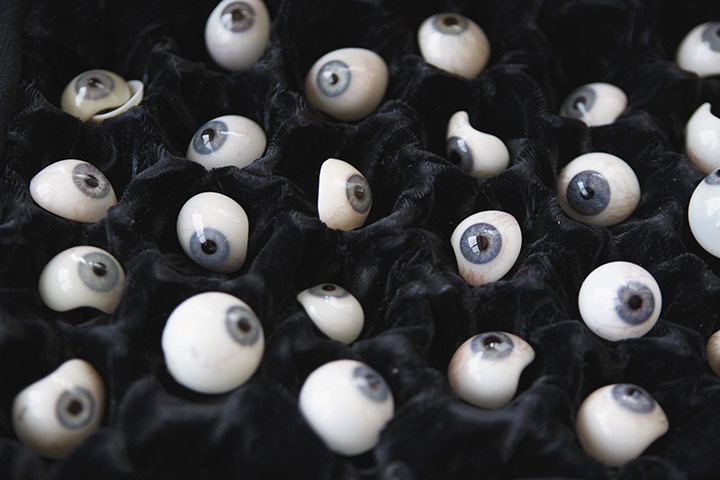Slide shows of the Best Photographs of 2011 are beginning to appear. They contain some great images, some eye candy, and another opportunity to think about the public world. One thing you won’t see much of this year, unless it’s in ruins, is infrastructure.
This photo of prosthetic eyeballs is not going to appear in any of the “Best of” shows, nor should it. And technological mimicry on behalf of cosmetics doesn’t quite qualify as old-school infrastructure, either. Once images of factories, bridges, and other examples of industrialization were an important genre of photography–for example, the cover of the first issue of Life Magazine featured a photograph by Margaret Bourke-White of Fort Peck Dam. Modernism articulated a strong affinity between the design arts, the machine age, and photography, and all three elements are fused in the Life cover with a good dose of national pride on behalf of progress and the American Century thrown in. That’s a lot harder to come by these days, and so one might settle for a case of machined eyeballs.
But perhaps the photographer isn’t settling. The image of mechanical eyes refers simultaneously to the human organ of sight and the camera, a visual prosthetic. The eyes in the photograph appear somewhat uncanny: one intuitively senses that they can’t see and yet one can’t help thinking that they can see–that they might even be little orbs of sight at this moment. They might be each looking in only one direction to see only one thing, but intelligent in at least that way. Although not really. Like a camera, one might say. These won’t in fact see anything, but a cyborg future awaits the civilization that mass produces eyes and other body parts, while the present world is already one in which we see virtually everything virtually, so much so that we forget that seeing itself requires its own organic, technological, social, and cultural infrastructure.
Once you start tracing the complex intersections that create photography’s ongoing contribution to the shared seeing that sustains modern societies, it’s not clear where to stop. Certainly not before you consider the role of the city and all that makes it work.
This is another photo that probably won’t win any contests but is nonetheless distinctive, and in this case eerily beautiful. The rectilinear grid pattern is etched in silver across the warm-toned base material, and it seems at once serenely ordered and yet strung with potential surges of energy. But what is it? A circuit board, or a laboratory apparatus, or an industrial park seen from above, or a work of art? The metal pieces actually are train tracks in Chicago. It’s an image of relatively low-tech infrastructure that is essential to life of the city and, with that, the economic health and cultural development of the nation.
But how often do we see that, much less look at it? Obviously, an image such as this one isn’t going to be sufficient for deliberating about transportation policy, any more than an image of plastic eyes is going to provide all that is needed to think about how we see. But each image is more than merely striking. They ask us to consider how much we depend on things that are taken for granted, and how those things might be not only necessary and in need of care but also strange and provocative and beautiful in their own right. Indeed, they are examples of how photography itself is part of the infrastructure of social thought.
Photographs by Lucas Jackson/Reuters and Brian Cassella/Chicago Tribune.


Speaking of infrastructure, here’s a photo from the series, “Live Wires”.
http://www.efn.org/~hkrieger/w0610.jpg